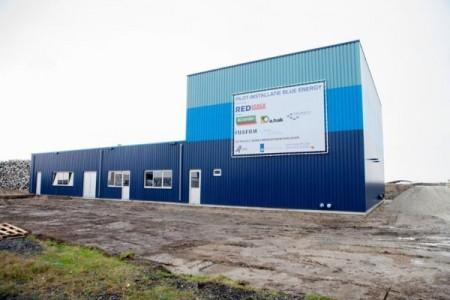 The first salinity gradient power station. (Credit: REDstack)
The first salinity gradient power station. (Credit: REDstack)
Next month, on the Afsluitdijk (Netherlands), the first salinity gradient power station in the world will start operations, with membranes that work via the transport of ions. Researchers from the University of Twente’s MESA+ research institute supplied the knowledge for the membranes and the technology for this power station.
Electricity can be generated wherever fresh water and salt water meet, for instance where rivers flow into the sea. This is because there are many more charged particles—ions—in salt water than in fresh water. Separating salt water from fresh water, using a membrane that only allows positively or negatively charged particles to permeate, results in a difference in voltage which you can convert into electricity. The principle has been known for some time, but its efficiency had always been far too low to make large-scale application interesting.
This is about to change. Next month, on the Afsluitdijk (Enclosure Dam in English), operations will commence in the first salinity gradient power station in the world that works on the basis of transporting ions. The total quantity of electricity that could be generated on the Afsluitdijk is equal to 1200 billion AA batteries a year, or, in other words, sufficient for the energy requirements of 500,000 households. This pilot power station is an important interim step between the research in the laboratory and a commercial power station.
This is an important step for continued development of the technology, according to prof. dr. ir. Kitty Nijmeijer of the MESA+ research institute of the University of Twente, who—together with her department—has spent the past eight years working intensively on developing and improving the membranes and the Blue Energy (salinity gradient) technology. “The technology is very promising. You could generate electricity for 80% of the households in the Netherlands just from the water that flows into the sea via the Dutch part of the Rhine. And worldwide you could use blue energy to total amount of electricity consumed.”
“At the moment our membranes in the lab can supply a capacity of about 1.3 watt per square meter. We need to increase this to 2 to 3 watt per square meter in order to make blue energy economically profitable. Our PhD candidates can use the power station on the Afsluitdijk as a research facility for improving efficiency on a large scale.”
The installation, which is being realized by, among others, REDstack BV and Fujifilm, already contains a total of four hundred square meters of membranes capable of processing 220,000 liters of salt water and 220,000 liters of fresh water per hour. This figure will be increased to 100,000 square meters during the next few years. Different membranes are placed immediately adjacent to one another, at a distance of 0.3–0.5 millimeter, in order to save space. A commercial installation will eventually need millions of square meters of membranes.
The research is a joint venture by the MESA+ research institute and the Green Energy Initiative of the University of Twente. The research involves intensive collaboration with the Wetsus research institute, REDstack, Fujifilm and the corporate sector.

